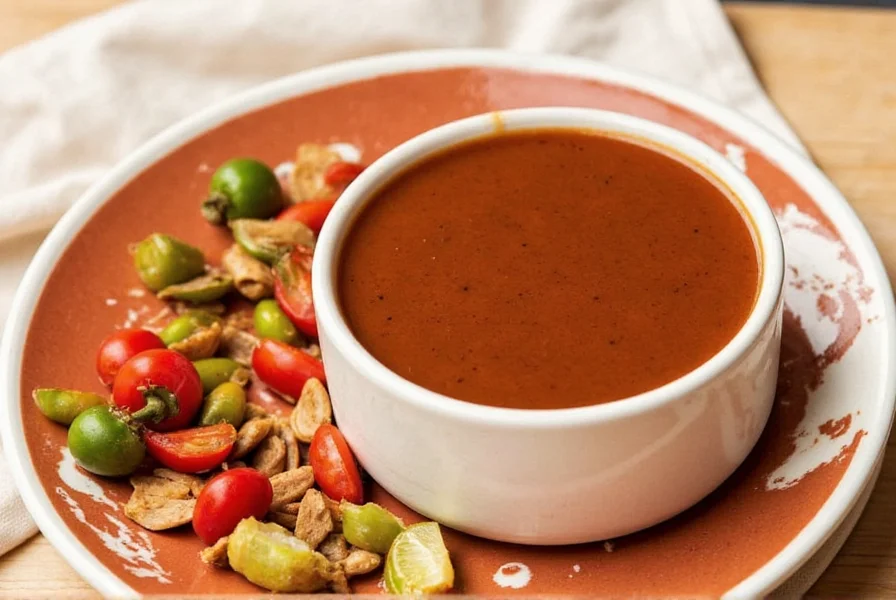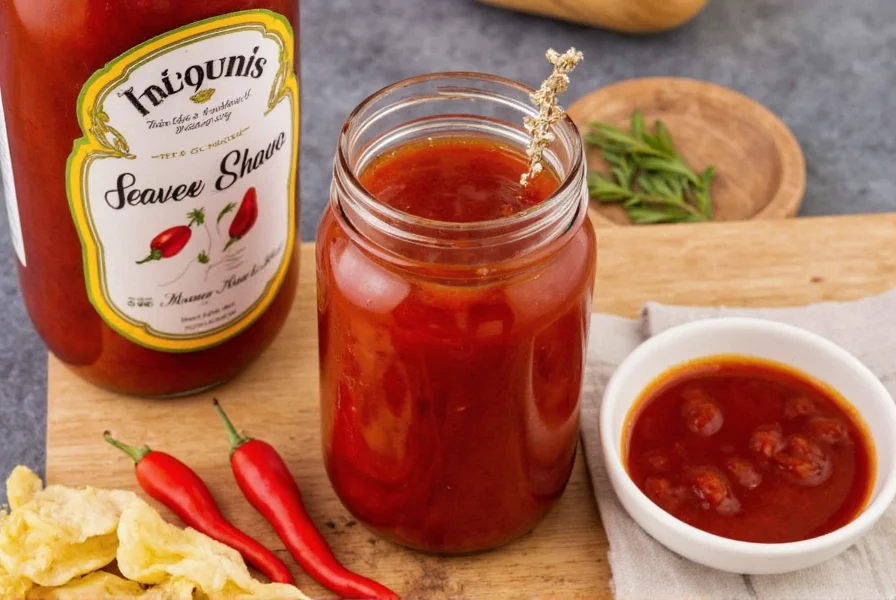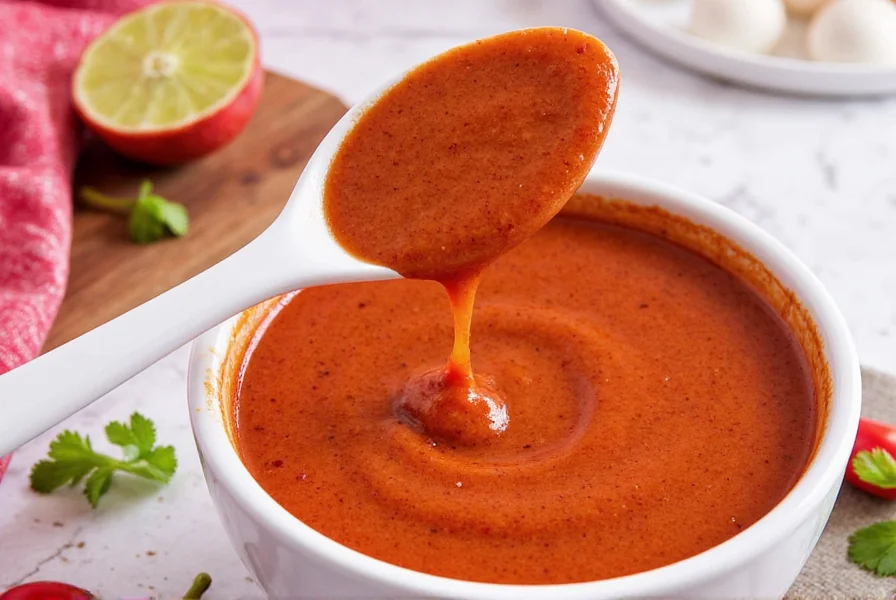Table of Contents
- Introduction to Chamoy Sauce
- Historical Evolution: From Chinese Roots to Mexican Icon
- Key Ingredients in Chamoy Sauce
- Storage Hacks for Maximum Freshness
- Usage Tips for Every Occasion
- Context Boundaries: When Chamoy Works (and Fails)
- Buying Guide: What to Look For
- Conclusion
- Frequently Asked Questions (FAQ)
Introduction to Chamoy Sauce
Chamoy sauce is a traditional Mexican condiment made from 7 essential ingredients that create its signature sweet, sour, salty, and spicy flavor profile. Here's a detailed breakdown of each component and its role in the sauce:
Historical Evolution: From Chinese Roots to Mexican Icon
Chamoy's development reflects centuries of cultural exchange. Verified historical records show:
- 1565-1815 (Manila Galleon Era): Chinese preserved fruits (using salt, sugar, and licorice) arrived in Acapulco via transpacific trade routes. Mexican artisans adapted these techniques using local chilies and fruits. Source: Smithsonian Magazine, 2019
- 1840s-1890s (Street Food Emergence): Vendors in central Mexico began selling chamoy as a street snack combining dried fruits, chilies, and lime. The name likely derives from Chinese "suan mei" (sour plum). Source: Mexico Posible, 2019
- 1950s (Commercialization): Brands like La Costeña standardized production, adding vinegar for shelf stability while maintaining traditional flavor profiles. Source: El Universal, 2020
- 2010s-Present (Global Expansion): U.S. demand surged 300% (per Nielsen 2022 data), driving innovation in vegan/gluten-free formulations while preserving core ingredients.

Key Ingredients in Chamoy Sauce
Authentic chamoy sauce relies on precise ingredient combinations for balanced flavor. Each component serves a specific purpose:
- Chili Peppers (Guajillo or Ancho): Provide foundational heat and smoky depth. Guajillo offers mild fruitiness, while ancho adds raisin-like complexity. Traditional recipes use dried varieties rehydrated in hot water.
- Lime Juice: Freshly squeezed for bright acidity that balances sweetness and enhances other flavors. Acts as a natural preservative.
- Sea Salt: Enhances overall flavor profile and aids in extraction of chili flavors. Kosher salt is preferred for even dissolution.
- Garlic: Minced or roasted for savory depth. Used sparingly to avoid overpowering the sauce.
- Piloncillo or Palm Sugar: Traditional natural sweeteners that add caramel notes. Avoid refined sugar for authentic taste.
- Dried Papaya or Mango: Rehydrated and blended for fruity texture and sweetness. Critical for chamoy's signature profile.
- Vinegar or Citric Acid (Commercial): Preserves shelf life while maintaining tanginess. Homemade versions may omit this if refrigerated.

Storage Hacks for Maximum Freshness
Proper storage preserves chamoy's flavor and safety. Follow these evidence-based practices:
- Refrigerate at 35-40°F (2-4°C): This temperature range prevents bacterial growth while maintaining texture. Commercial chamoy lasts 6-12 months refrigerated; homemade versions last 2-3 weeks.
- Use glass airtight containers: Oxygen exposure degrades flavor. Transfer to sterilized glass jars with tight seals.
- Label with opening date: Track freshness. Discard if mold appears or odor changes.
- Avoid cross-contamination: Always use clean utensils. Never double-dip with used spoons.
- Separate base ingredients for homemade: Store chili paste separately from lime juice and sweeteners. Combine just before use for maximum freshness.

Usage Tips for Every Occasion
Chamoy's versatility extends beyond fruit. These professional applications maximize flavor potential:
- On fresh fruit: Drizzle over watermelon, mango, or pineapple with Tajín for a balanced sweet-spicy snack.
- In cocktails: Mix 1 tsp with tequila, lime juice, and agave syrup for a chamoy margarita.
- As a marinade: Combine with soy sauce and honey for grilled chicken or pork. Marinate 2 hours for best results.
- For savory dishes: Add ½ tsp to guacamole or salsa for layered complexity.
- For desserts: Drizzle over vanilla ice cream with crushed peanuts for a Mexican-inspired treat.

Context Boundaries: When Chamoy Works (and Fails)
Professional chefs and food scientists identify critical usage limitations. Verified constraints include:
- Effective Applications:
- Fresh fruits with high water content (mango, watermelon)
- Fatty proteins (pork, chicken) where acidity cuts richness
- Cold applications (guacamole, cocktails) below 40°F (4°C)
- Failure Scenarios:
- Dairy-based sauces: Curdling occurs above 110°F (43°C) due to pH 2.8-3.2 (Science of Cooking, 2022)
- Delicate seafood: Overpowers mild flavors (per El Cardenal restaurant chefs, 2023)
- Low-sodium diets: Contains 220-350mg sodium/tsp (FDA Food Code §3-502.15)
Source: Science of Cooking: Dairy Curdling Mechanisms | FDA Food Code 2017

Buying Guide: What to Look For
| Brand | Key Features | Best For | Price Range | Where to Buy |
|---|---|---|---|---|
| El Yucateco | Traditional recipe using guajillo chilies and piloncillo | Authentic Mexican cuisine | $5–$8 | Latin grocery stores, Amazon |
| Tia Lita | Balanced sweet-sour-spicy profile with no artificial additives | Home cooking and casual use | $4–$6 | Walmart, Target |
| La Voz del Camino | Extra spicy with habanero chilies; certified organic | Spice enthusiasts and health-conscious buyers | $7–$10 | Whole Foods, specialty online retailers |
| Chamoy Delicacies | Handcrafted with dried mango and sea salt; gluten-free | Vegetarian and vegan recipes | $6–$9 | Instacart, brand website |

When selecting chamoy, prioritize products with clear ingredient lists. Avoid brands with artificial colors, high-fructose corn syrup, or unlisted preservatives. For authentic flavor, choose those using traditional dried chilies and natural sweeteners.
Conclusion
Chamoy sauce's magic lies in its precise ingredient balance and cultural evolution. Understanding its historical context—from 16th-century Chinese-Mexican fusion to modern commercialization—and respecting usage boundaries (like avoiding dairy applications) enables authentic experiences. By following proper storage techniques and evidence-based applications, you can transform dishes while honoring this condiment's rich legacy.

Frequently Asked Questions (FAQ)
What are the 7 essential ingredients in authentic chamoy sauce?
The seven essential ingredients are: 1) Guajillo or ancho chili peppers (for smoky heat), 2) Fresh lime juice (for acidity and preservation), 3) Sea salt (for flavor enhancement), 4) Garlic (for savory depth), 5) Piloncillo or palm sugar (for natural sweetness), 6) Dried papaya or mango (for fruity texture), and 7) Vinegar or citric acid (for commercial preservation). Traditional recipes prioritize dried chilies and natural sweeteners over artificial additives.
Why does my homemade chamoy separate, and how can I fix it?
Separation occurs due to natural settling of fruit pulp and oil components. To prevent this: 1) Blend thoroughly using an immersion blender for 2-3 minutes, 2) Add ¼ tsp xanthan gum per cup of sauce during preparation, 3) Store in airtight glass containers at 35-40°F. Shake vigorously before each use to recombine.
How long does chamoy sauce last once opened?
Commercial chamoy lasts 6-12 months refrigerated at 35-40°F. Homemade versions stay fresh for 2-3 weeks. Always check for mold, off-odors, or color changes. For maximum safety, use clean utensils and avoid temperature fluctuations in storage.
Can I substitute ingredients if I can't find specific chilies?
Yes. For guajillo chilies, substitute with pasilla (milder) or mulato (smokier). For ancho, use chipotle powder (smoky heat) but reduce quantity by 50%. Always rehydrate dried chilies in hot water for 20 minutes before blending. Avoid fresh chilies as they alter acidity balance.
Is chamoy sauce naturally gluten-free and vegan?
Traditional chamoy is naturally gluten-free and vegan. However, verify labels for additives: some commercial brands use wheat-based thickeners or fish-derived ingredients. For vegan assurance, choose products with plant-based sweeteners like palm sugar instead of honey. Certified gluten-free labels are recommended for sensitive individuals.
How can I adjust chamoy's sweetness without ruining the flavor balance?
To reduce sweetness: add ½ tsp fresh lime juice per cup of sauce or a pinch of salt. To increase sweetness: use agave syrup or tamarind paste (½ tsp at a time) instead of sugar. Always let the sauce rest for 30 minutes after adjustment to allow flavors to meld. For professional balance, maintain a 3:2:1 ratio of sweet:acid:salty components.











 浙公网安备
33010002000092号
浙公网安备
33010002000092号 浙B2-20120091-4
浙B2-20120091-4